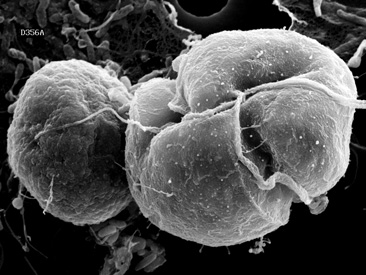New NCCOS-sponsored research shows the importance of “mixotrophy”—the ability to photosynthesize like a plant and consume like an animal—to the growth of some single-celled organisms, such as the toxic dinoflagellate Karlodinium. The study, supported in part by an NCCOS ECOHAB project, provides information that will allow scientists to improve the models that predict harmful algal blooms (HABs).

Traditionally, biologists classified organisms as either autotrophs, which produce their energy internally via chemo- or photosynthesis, or heterotrophs, which are unable to produce their own food and require external food sources for energy. In many algae, including some HABs, an intermediate form of energy production is recognized, called mixotrophy. Mixotrophy is the capability of one organism to be autotrophic and heterotrophic at the same time.
Among single-celled algae, mixotropy is common among some flagellated species (e.g., dinoflagellates, chrysophytes, haptophytes) which were once classified by zoologists as protozoa. Mixotrophy gives Karlodinium, and other similarly endowed single-cell photosynthetic “protists,” the ability to keep growing under altered nutrient conditions and warming temperatures.
Despite increasing understanding of mixotrophy in plankton, modeling plankton community dynamics under mixotrophy is a developing field of study. For simplicity, most model approaches separate out autotrophy and heterotrophy as independent variables. This study successfully modified a previous model that integrated both autotrophy and heterotrophy. Using experimental datasets, researchers from the University of Maryland Horn Point Laboratory used the modified model to explore growth scenarios of the harmful algal dinoflagellate Karlodinium veneficum and its algal prey Rhodomonas, under varying nutrient and temperature conditions.
The model results showed that under non-normal nutrient conditions (i.e., very low or high nitrogen and/or phosphorus) K. veneficum became more mixotrophic, rather than autotrophic, and grew faster. Also, increasing water temperatures stimulated more prey availability for K. veneficum to eat, enhancing mixotrophy. Thus mixotrophy can promote harmful algal blooms (HABs) under unfavorable nutrient conditions and under warming temperatures that promote prey.
The model responses of K. veneficum to variable nutrients, increasing temperatures, and more prey, give insight into HAB dynamics under possible future warming conditions.
For more information, contact Quay Dortch.
